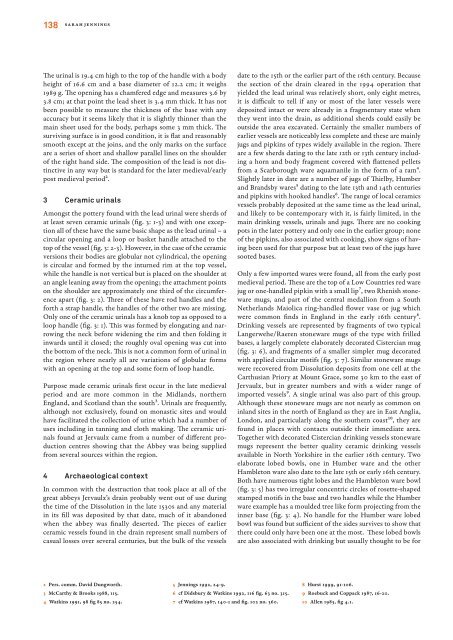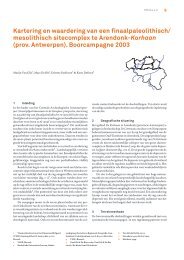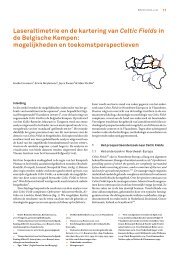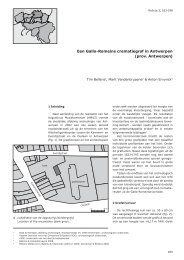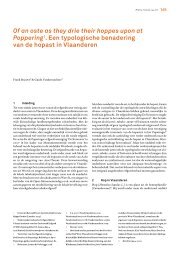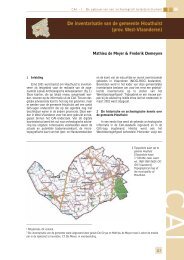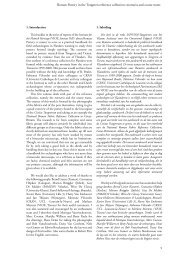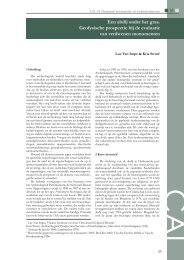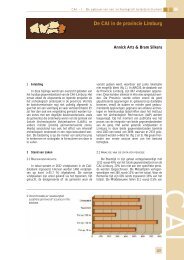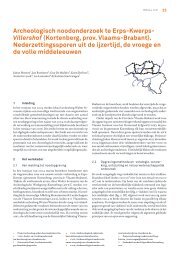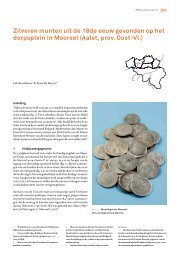Exchanging Medieval Material Culture Studies on archaeology and ...
Exchanging Medieval Material Culture Studies on archaeology and ...
Exchanging Medieval Material Culture Studies on archaeology and ...
You also want an ePaper? Increase the reach of your titles
YUMPU automatically turns print PDFs into web optimized ePapers that Google loves.
138<br />
Sarah Jennings<br />
Th e urinal is 19.4 cm high to the top of the h<strong>and</strong>le with a body<br />
height of 16.6 cm <strong>and</strong> a base diameter of 12.2 cm; it weighs<br />
1989 g. Th e opening has a chamfered edge <strong>and</strong> measures 3.6 by<br />
3.8 cm; at that point the lead sheet is 3.4 mm thick. It has not<br />
been possible to measure the thickness of the base with any<br />
accuracy but it seems likely that it is slightly thinner than the<br />
main sheet used for the body, perhaps some 3 mm thick. Th e<br />
surviving surface is in good c<strong>on</strong>diti<strong>on</strong>, it is fl at <strong>and</strong> reas<strong>on</strong>ably<br />
smooth except at the joins, <strong>and</strong> the <strong>on</strong>ly marks <strong>on</strong> the surface<br />
are a series of short <strong>and</strong> shallow parallel lines <strong>on</strong> the shoulder<br />
of the right h<strong>and</strong> side. Th e compositi<strong>on</strong> of the lead is not distinctive<br />
in any way but is st<strong>and</strong>ard for the later medieval/early<br />
post medieval period2.<br />
3 Ceramic urinals<br />
Am<strong>on</strong>gst the pottery found with the lead urinal were sherds of<br />
at least seven ceramic urinals (fi g. 3: 1-3) <strong>and</strong> with <strong>on</strong>e excepti<strong>on</strong><br />
all of these have the same basic shape as the lead urinal – a<br />
circular opening <strong>and</strong> a loop or basket h<strong>and</strong>le attached to the<br />
top of the vessel (fi g. 3: 2-3). However, in the case of the ceramic<br />
versi<strong>on</strong>s their bodies are globular not cylindrical, the opening<br />
is circular <strong>and</strong> formed by the inturned rim at the top vessel,<br />
while the h<strong>and</strong>le is not vertical but is placed <strong>on</strong> the shoulder at<br />
an angle leaning away from the opening; the attachment points<br />
<strong>on</strong> the shoulder are approximately <strong>on</strong>e third of the circumference<br />
apart (fi g. 3: 2). Th ree of these have rod h<strong>and</strong>les <strong>and</strong> the<br />
forth a strap h<strong>and</strong>le, the h<strong>and</strong>les of the other two are missing.<br />
Only <strong>on</strong>e of the ceramic urinals has a knob top as opposed to a<br />
loop h<strong>and</strong>le (fi g. 3: 1). Th is was formed by el<strong>on</strong>gating <strong>and</strong> narrowing<br />
the neck before widening the rim <strong>and</strong> then folding it<br />
inwards until it closed; the roughly oval opening was cut into<br />
the bottom of the neck. Th is is not a comm<strong>on</strong> form of urinal in<br />
the regi<strong>on</strong> where nearly all are variati<strong>on</strong>s of globular forms<br />
with an opening at the top <strong>and</strong> some form of loop h<strong>and</strong>le.<br />
Purpose made ceramic urinals fi rst occur in the late medieval<br />
period <strong>and</strong> are more comm<strong>on</strong> in the Midl<strong>and</strong>s, northern<br />
Engl<strong>and</strong>, <strong>and</strong> Scotl<strong>and</strong> than the south3. Urinals are frequently,<br />
although not exclusively, found <strong>on</strong> m<strong>on</strong>astic sites <strong>and</strong> would<br />
have facilitated the collecti<strong>on</strong> of urine which had a number of<br />
uses including in tanning <strong>and</strong> cloth making. Th e ceramic urinals<br />
found at Jervaulx came from a number of diff erent producti<strong>on</strong><br />
centres showing that the Abbey was being supplied<br />
from several sources within the regi<strong>on</strong>.<br />
4 Archaeological c<strong>on</strong>text<br />
In comm<strong>on</strong> with the destructi<strong>on</strong> that took place at all of the<br />
great abbeys Jervaulx’s drain probably went out of use during<br />
the time of the Dissoluti<strong>on</strong> in the late 1530s <strong>and</strong> any material<br />
in its fi ll was deposited by that date, much of it ab<strong>and</strong><strong>on</strong>ed<br />
when the abbey was fi nally deserted. Th e pieces of earlier<br />
ceramic vessels found in the drain represent small numbers of<br />
casual losses over several centuries, but the bulk of the vessels<br />
2 Pers. comm. David Dungworth.<br />
3 McCarthy & Brooks 1988, 115.<br />
4 Watkins 1991, 98 fi g 85 no. 254.<br />
5 Jennings 1992, 24-9.<br />
6 cf Didsbury & Watkins 1992, 116 fi g. 63 no. 315.<br />
7 cf Watkins 1987, 140-1 <strong>and</strong> fi g. 102 no. 360.<br />
date to the 15th or the earlier part of the 16th century. Because<br />
the secti<strong>on</strong> of the drain cleared in the 1994 operati<strong>on</strong> that<br />
yielded the lead urinal was relatively short, <strong>on</strong>ly eight metres,<br />
it is diffi cult to tell if any or most of the later vessels were<br />
deposited intact or were already in a fragmentary state when<br />
they went into the drain, as additi<strong>on</strong>al sherds could easily be<br />
outside the area excavated. Certainly the smaller numbers of<br />
earlier vessels are noticeably less complete <strong>and</strong> these are mainly<br />
jugs <strong>and</strong> pipkins of types widely available in the regi<strong>on</strong>. Th ere<br />
are a few sherds dating to the late 12th or 13th century including<br />
a horn <strong>and</strong> body fragment covered with fl attened pellets<br />
from a Scarborough ware aquamanile in the form of a ram4.<br />
Slightly later in date are a number of jugs of Th irlby, Humber<br />
<strong>and</strong> Br<strong>and</strong>sby wares5 dating to the late 13th <strong>and</strong> 14th centuries<br />
<strong>and</strong> pipkins with hooked h<strong>and</strong>les6. Th e range of local ceramics<br />
vessels probably deposited at the same time as the lead urinal,<br />
<strong>and</strong> likely to be c<strong>on</strong>temporary with it, is fairly limited, in the<br />
main drinking vessels, urinals <strong>and</strong> jugs. Th ere are no cooking<br />
pots in the later pottery <strong>and</strong> <strong>on</strong>ly <strong>on</strong>e in the earlier group; n<strong>on</strong>e<br />
of the pipkins, also associated with cooking, show signs of having<br />
been used for that purpose but at least two of the jugs have<br />
sooted bases.<br />
Only a few imported wares were found, all from the early post<br />
medieval period. Th ese are the top of a Low Countries red ware<br />
jug or <strong>on</strong>e-h<strong>and</strong>led pipkin with a small lip7, two Rhenish st<strong>on</strong>eware<br />
mugs, <strong>and</strong> part of the central medalli<strong>on</strong> from a South<br />
Netherl<strong>and</strong>s Maiolica ring-h<strong>and</strong>led fl ower vase or jug which<br />
were comm<strong>on</strong> fi nds in Engl<strong>and</strong> in the early 16th century8.<br />
Drinking vessels are represented by fragments of two typical<br />
Langerwehe/Raeren st<strong>on</strong>eware mugs of the type with frilled<br />
bases, a largely complete elaborately decorated Cistercian mug<br />
(fi g. 3: 6), <strong>and</strong> fragments of a smaller simpler mug decorated<br />
with applied circular motifs (fi g. 3: 7). Similar st<strong>on</strong>eware mugs<br />
were recovered from Dissoluti<strong>on</strong> deposits from <strong>on</strong>e cell at the<br />
Carthusian Priory at Mount Grace, some 30 km to the east of<br />
Jervaulx, but in greater numbers <strong>and</strong> with a wider range of<br />
imported vessels9. A single urinal was also part of this group.<br />
Although these st<strong>on</strong>eware mugs are not nearly as comm<strong>on</strong> <strong>on</strong><br />
inl<strong>and</strong> sites in the north of Engl<strong>and</strong> as they are in East Anglia,<br />
L<strong>on</strong>d<strong>on</strong>, <strong>and</strong> particularly al<strong>on</strong>g the southern coast10, they are<br />
found in places with c<strong>on</strong>tacts outside their immediate area.<br />
Together with decorated Cistercian drinking vessels st<strong>on</strong>eware<br />
mugs represent the better quality ceramic drinking vessels<br />
available in North Yorkshire in the earlier 16th century. Two<br />
elaborate lobed bowls, <strong>on</strong>e in Humber ware <strong>and</strong> the other<br />
Hamblet<strong>on</strong> ware also date to the late 15th or early 16th century.<br />
Both have numerous tight lobes <strong>and</strong> the Hamblet<strong>on</strong> ware bowl<br />
(fi g. 3: 5) has two irregular c<strong>on</strong>centric circles of rosette-shaped<br />
stamped motifs in the base <strong>and</strong> two h<strong>and</strong>les while the Humber<br />
ware example has a moulded tree like form projecting from the<br />
inner base (fi g. 3: 4). No h<strong>and</strong>le for the Humber ware lobed<br />
bowl was found but suffi cient of the sides survives to show that<br />
there could <strong>on</strong>ly have been <strong>on</strong>e at the most. Th ese lobed bowls<br />
are also associated with drinking but usually thought to be for<br />
8 Hurst 1999, 91-106.<br />
9 Roebuck <strong>and</strong> Coppack 1987, 16-20.<br />
10 Allen 1983, fi g 4.1.


